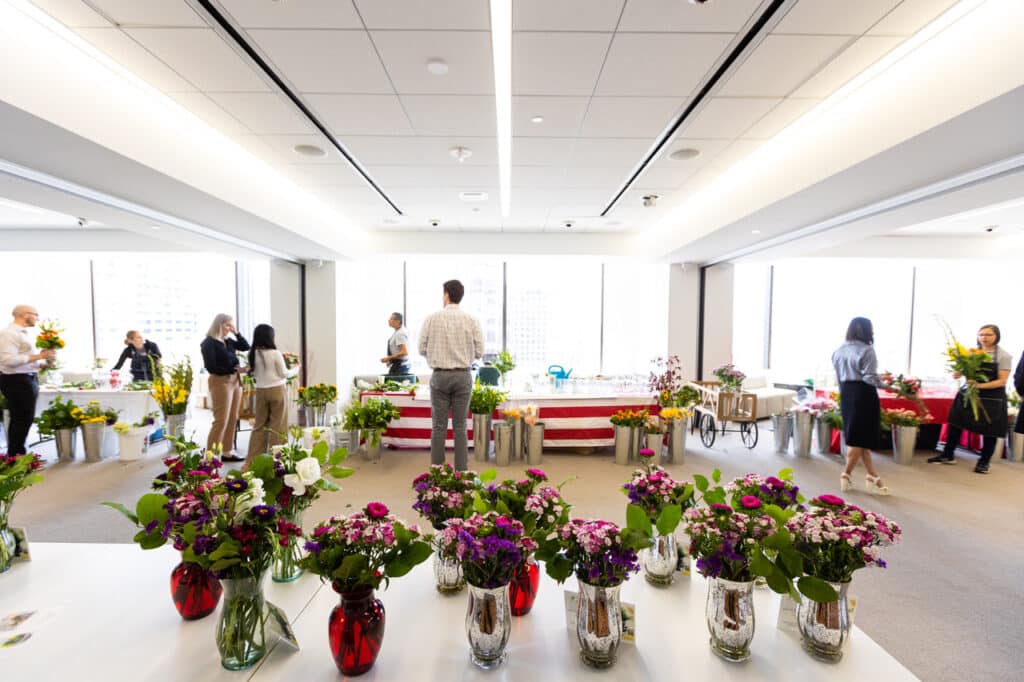Floral arrangements communicate your brand’s personality and create memorable experiences. Different business environments demand distinct approaches to floral design.
Here’s how to match commercial flower arrangements to specific commercial spaces while maintaining practicality and visual impact.
Reception Areas
The reception desk sets the tone for visitor experiences. Opt for medium-height arrangements that don’t obstruct sightlines between staff and guests. Tropical flowers like anthuriums or orchids in sleek vases convey sophistication for corporate offices. Creative agencies might prefer wildflower clusters in colored glass for an energetic vibe.
For small reception areas, wall-mounted floral installations save counter space while adding vertical interest. In expansive lobbies, pair floor-standing arrangements with potted plants to create natural pathways. Seasonal blooms, such as peonies in spring or chrysanthemums in autumn, keep the look current without requiring constant redesign.
Conference Rooms
Conference table centerpieces should facilitate conversation rather than block it. Low-profile arrangements in rectangular planters work well for long tables. Incorporate your brand colors through flowers like blue delphiniums or purple lisianthus.
For boardrooms hosting video calls, use monochromatic white arrangements that appear crisp on camera.
In brainstorming rooms, fragrant herbs like lavender or eucalyptus can stimulate creativity. Place small bud vases at each seat for intimate client meetings. Avoid strongly scented flowers like lilies in enclosed spaces where they might overwhelm.
Collaborative Workspaces
Open-plan offices benefit from floral zones that define areas without walls. Use hanging planters with trailing flowers like begonias above communal tables. Desktop terrariums with air plants and miniature blooms add personality to individual workstations without clutter.
For break rooms, edible flower arrangements with pansies or nasturtiums double as conversation starters and cocktail garnishes. In stairwells, install rotating floral displays that employees discover when moving between floors. These unexpected touches boost morale through visual variety.
Healthcare Environments
Medical offices require careful floral selection. Hypoallergenic options like hydrangeas or closed tulips minimize pollen concerns. Avoid spiky or fragile flowers in high-traffic areas. For senior care facilities, incorporate nostalgic blooms like roses or carnations that trigger positive memories.
In therapy offices, use asymmetrical arrangements to create relaxed, organic energy. Dental waiting rooms benefit from tall, narrow designs that don’t interfere with cleaning protocols. Always secure containers to prevent tipping near medical equipment.
Retail Spaces
Boutiques should match flowers to merchandise seasons. Spring clothing launches pair well with pastel ranunculus, while winter sales events shine alongside amaryllis and pinecones. Place fragrant stocks near cash wraps to create positive final impressions.
For high-end stores, minimalist ikebana-inspired arrangements emphasize product displays. Grocery stores can incorporate edible flowers near produce sections or floral departments. Rotate arrangements weekly to signal fresh inventory to regular customers.
Hospitality Venues
Hotels need durable arrangements that maintain freshness. In lobbies, use tropical flowers like birds-of-paradise that withstand temperature fluctuations. Guest rooms benefit from small succulents or preserved flowers requiring no maintenance.
Restaurants should avoid flowers competing with food aromas. Herbs like rosemary or flowering thyme complement menus while serving dual purposes.
For bars, freeze edible flowers into ice cubes for signature cocktails displayed alongside matching arrangements.
Financial Institutions
Banks and law offices project stability through classic designs. Symmetrical arrangements with roses or calla lilies in neutral color palettes reinforce professionalism. Incorporate metallic accents in vases to echo corporate branding without overwhelming.
Wealth management firms can use premium flowers like gardenias or peonies to subtly communicate exclusivity.
Credit unions aiming for community connections might feature locally grown seasonal blooms with handwritten origin cards.
Technology Companies
Tech offices often prefer unconventional professional floral designs. Geometric terrariums with succulents and LED lighting appeal to engineering minds. For gaming companies, incorporate pixel-inspired floral mosaics using color-blocked petals.
Server rooms can feature preserved moss walls that absorb sound without moisture risks. Startup spaces benefit from DIY flower stations where employees arrange weekly blooms is a cost-effective team-building activity.
Educational Facilities
University admin offices should opt for low-maintenance orchids or peace lilies that survive semester breaks. Preschools can use felt flowers in bright colors for cheer without choking hazards.
In libraries, dried flower installations prevent pollen issues near rare books. Science departments might showcase carnivorous plants or blooming species mentioned in curriculum materials.
Professional Services
Architecture firms can mirror structural designs through linear arrangements with bold shapes. Marketing agencies might create flower walls for client photo backdrops. Accounting offices during tax season benefit from stress-reducing lavender arrangements.
For co-working spaces, use mobile flower carts that members can position as needed. Include plant-care instructions as part of onboarding materials to foster community responsibility.
Maintenance Strategies for Lasting Impact
For DIY care, establish clear watering charts and designate staff floral ambassadors. Use flower food packets and clean vases regularly to extend the arrangement’s life. Consider preserved or silk flowers for areas with extreme temperature fluctuations.
Finally, implement a rotation schedule where arrangements move from high-visibility areas to staff spaces as they begin to fade, maximizing budget efficiency.
Ultimately, you’ll also want to partner with a local floral design company that provides weekly refresh services to maintain crisp appearances.

